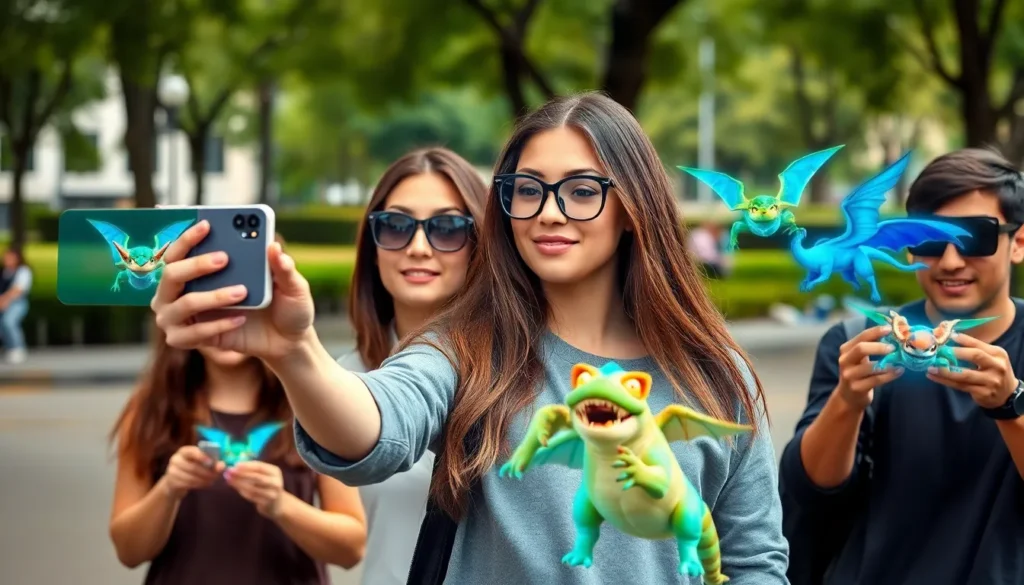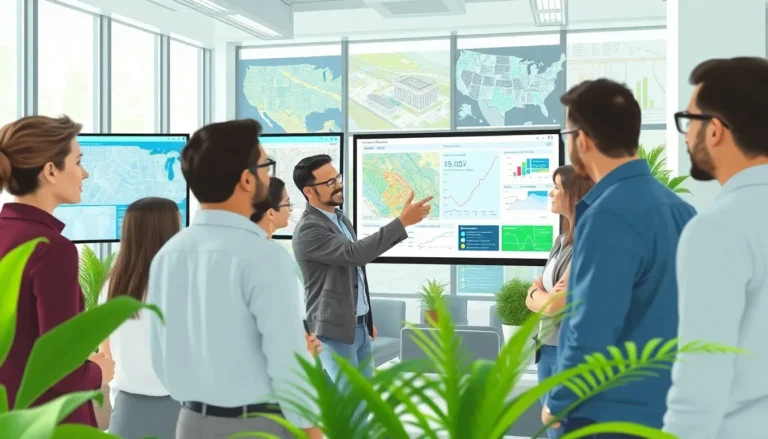Table of Contents
ToggleImagine walking through a museum and suddenly, the paintings start chatting with you. Or picture yourself trying on a new pair of shoes without leaving your couch. Welcome to the world of augmented reality, where the ordinary becomes extraordinary. This tech wizardry blends the digital and real worlds, creating experiences that are not just cool but also practical.
From gaming to education and even shopping, augmented reality is changing how we interact with our environment. It’s not just a flashy gimmick; it’s a powerful tool that enhances our daily lives. Dive into the fascinating examples of augmented reality that are redefining what’s possible. Get ready to be amazed, entertained, and maybe even a little confused—who knew technology could be this fun?
Overview of Augmented Reality
Augmented reality (AR) blends digital information with the real world, providing users with unique interactions. Users can engage with their environment in new ways by overlaying digital elements onto physical objects or spaces. This technology transforms various industries by enhancing user experiences and improving engagement.
In gaming, AR adds a layer of immersion, allowing players to interact with their surroundings. Popular games like Pokémon GO demonstrate this by placing virtual creatures in real-world locations. Educational institutions adopt AR tools for interactive learning, enabling students to visualize complex concepts. For instance, anatomy apps allow learners to explore the human body in 3D, enhancing understanding.
Shopping benefits significantly from AR applications. Retailers implement AR features that let customers visualize products in their homes before purchasing. IKEA Place, for example, allows users to see how furniture fits within their spaces. This functionality reduces uncertainty and enhances customer satisfaction.
Furthermore, AR finds applications in healthcare. Surgeons utilize AR to visualize critical data during procedures, improving precision. This integration demonstrates AR’s potential to elevate not only skillsets but also patient outcomes.
As AR technology advances, its integration into daily life becomes increasingly seamless. Enhanced navigation apps visualize directions directly onto the user’s surroundings. Additionally, marketing campaigns leverage AR to create interactive advertisements, capturing consumer attention more effectively.
The continuous development of AR technologies suggests its significant impact across diverse fields. Case studies show improvements in user engagement and satisfaction, emphasizing the transformative potential of AR. These benefits contribute to the changing landscape of how individuals interact with the digital and physical worlds.
Popular Augmented Reality Examples

Augmented reality showcases innovative applications across different sectors. Notable examples include mobile applications, gaming experiences, and educational tools.
Mobile Applications
Mobile applications leverage augmented reality to enhance user interaction. Snapchat uses AR filters to overlay graphics on users’ faces, adding entertainment and personalization. Popular shopping apps like Sephora utilize AR to enable customers to try on makeup virtually, improving the buying experience. Users can see how products look without the need to physically try them on. Similarly, Google Lens allows users to identify objects, translating text or providing information instantly by simply pointing their smartphone cameras. These applications transform everyday tasks with engaging and practical solutions.
Gaming Experiences
Gaming experiences significantly benefit from augmented reality features. Pokémon GO revolutionized mobile gaming by encouraging players to explore their neighborhoods to catch virtual creatures superimposed on real-world locations. The game created social interactions and increased physical activity among users. Additionally, games like Ingress allow players to participate in a unique experience by layer interactions around real-world landmarks. This approach fosters teamwork and competition in a blended environment. Overall, AR enhances immersion in gaming, creating dynamic and interactive experiences for players.
Educational Tools
Educational tools increasingly incorporate augmented reality for improved learning. Applications such as Merge Cube enable students to interact with 3D models of complex subjects like anatomy or history, fostering deeper understanding. Science classes benefit from AR experiences that visualize chemical reactions or biological processes in real time. Museums and galleries adopt AR to provide interactive experiences, letting visitors engage with exhibits through their devices. Teachers find these tools helpful for capturing attention while enhancing knowledge retention. Hence, augmented reality enriches education, making learning more engaging and effective.
Augmented Reality in Industries
Augmented reality (AR) plays a pivotal role in transforming various industries, enhancing functionality and user experiences.
Healthcare Innovations
In healthcare, AR technology supports surgeons during complex procedures by overlaying critical patient data. Tools like Microsoft HoloLens enable real-time visualization of anatomy, allowing for precise navigation. Surgeons can access important information without losing focus on the patient. Medical training benefits significantly from AR applications as students practice procedures in simulated environments. Through realistic scenarios, trainees gain confidence and skills necessary for their future careers. Enhancements in diagnostics stem from AR’s ability to provide additional insights, aiding clinicians in decision-making. Overall, AR’s integration into healthcare signifies a growing trend toward improved surgical outcomes and educational effectiveness.
Retail Enhancements
Retail benefits greatly from AR applications that enhance customer experiences and boost sales. Virtual try-on solutions, like those offered by Sephora, enable users to test cosmetics through their smartphones. Shoppers visualize how products fit into their homes using IKEA’s augmented reality app. Enhanced product previews entice customers, leading to more informed purchasing decisions. In physical stores, AR displays provide interactive shopping experiences, engaging consumers and increasing foot traffic. Gamified shopping experiences utilize AR elements to make purchasing fun and informative. Retailers adopting AR technologies gain competitive advantages, improving customer satisfaction and loyalty.
Future Trends in Augmented Reality
Emerging trends in augmented reality (AR) focus on enhancing user interactions and integrating AR into everyday scenarios. Healthcare sees exciting developments, notably in surgical applications. Surgeons utilize AR to visualize vital information during operations, improving precision in complex procedures.
Another trend involves the retail sector, where customer engagement continues to evolve. Retailers employ AR for virtual try-ons, allowing customers to visualize products directly in their environments. Enhanced shopping experiences foster better consumer connections, driving increased foot traffic to stores.
Education is undergoing a transformation through AR applications as well. Interactive learning tools provide students with immersive experiences, facilitating deeper understanding of intricate subjects. Augmented reality enables learners to visualize anatomical structures in three dimensions, making lessons more impactful.
Furthermore, the gaming industry is set for advancements in AR technology. New titles promise increased immersion by blending gaming with real-world experiences. Gamers enjoy interactions with their surroundings that enhance gameplay dynamics, leading to greater player engagement.
Marketers are also capitalizing on AR’s potential. Interactive advertising campaigns draw consumers’ attention, creating memorable brand experiences. Brands integrating AR into their marketing strategies enjoy improved recognition and customer loyalty.
Overall, the continuous innovation of AR technologies drives applications across various fields. Enhanced navigation apps and real-time interactive tutorials suggest a future where AR seamlessly integrates into daily life. The combination of practicality and entertainment positions AR as a significant influence on future developments.
Augmented reality is reshaping how individuals interact with their surroundings. Its applications span gaming, education, retail, and healthcare, showcasing its versatility and potential to enhance everyday experiences. As AR technology continues to evolve, it promises to integrate further into daily life, making interactions more engaging and informative. The possibilities are endless, and the future of AR holds exciting prospects for innovation across various sectors. Embracing this technology will undoubtedly lead to new ways of learning, shopping, and playing, ultimately enriching people’s lives.







